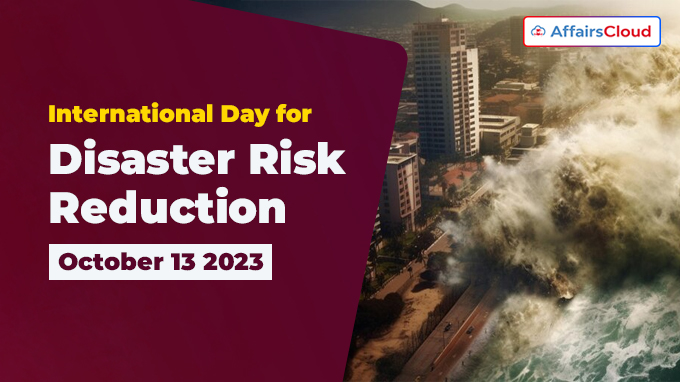 The United Nations (UN) International Day for Disaster Risk Reduction (IDDRR) is annually observed across the globe on 13 October to promote a global culture of risk awareness and disaster reduction.
The United Nations (UN) International Day for Disaster Risk Reduction (IDDRR) is annually observed across the globe on 13 October to promote a global culture of risk awareness and disaster reduction.
- The day serves as a platform to recognise and celebrate the efforts of individuals and communities worldwide in mitigating disaster risks.
The theme of IDDRR 2023 is “Fighting inequality for a resilient future.”
- The theme focuses on the close interconnection between disasters and inequality. Recognizing the link between disasters and inequality is critical for effective disaster response and recovery, as well as long-term resilience.
- The theme aligns with the Sendai Framework for Disaster Risk Reduction 2015-2030 (SFDRR).
Background:
i.In 1989, the United Nations General Assembly (UNGA) adopted the resolution A/RES/44/236 and proclaimed the decade 1990 – 1999 beginning on 1st January 1990 as “International Decade for Natural Disaster Reduction” . The resolution also proclaimed to celebrate the 2nd Wednesday of October througout the decade as “International Day for Natural Disaster Reduction (IDNDR)”
- The first International Day for Natural Disaster Reduction (IDNDR) was observed on 10 October 1990.
ii.In 2009, the UNGA adopted the a resolution A/RES/64/200 and officially designated 13 October as the International Day for Disaster Risk Reduction.
- Since 2010, IDDRR has been annually observed on 13 October.
Sendai Framework for Disaster Risk Reduction 2015-2030:
i.The Sendai Framework for Disaster Risk Reduction 2015-2030 (SFDRR) was adopted at the 3rd UN World Conference on Disaster Risk Reduction in Sendai, Japan, on March 18, 2015.
ii.The SFDRR outlines 7 clear targets and 4 priorities for action to prevent new and reduce existing disaster risks:
- Understanding disaster risk;
- Strengthening disaster risk governance to manage disaster risk;
- Investing in disaster reduction for resilience and;
- Enhancing disaster preparedness for effective response, and to “Build Back Better” in recovery, rehabilitation, and reconstruction.
iii.It was the first major agreement of the post-2015 development agenda that aims to achieve a substantial reduction of disaster risk and to prevent and reduce losses in lives, livelihoods, economies, and basic infrastructure.
iv.The 2023 IDDRR took place after the Midterm Review of SFDRR, where the UNGA in May 2023 adopted a political declaration to accelerate action to strengthen disaster resilience.
v.UN Office for Disaster Risk Reduction (UNDRR) (formerly UN International Strategy for Disaster Reduction (UNISDR)) is a part of the UN Secretariat that supports the implementation and review of the Sendai Framework.
Note:
- UNDRR is a member of the UN Sustainable Development Group (UNSDG).
Global Assessment Report on Disaster Risk Reduction:
i.The UN Global Assessment Report on Disaster Risk Reduction (GAR 2023) is the flagship report of the United Nations on worldwide efforts to reduce disaster risk.
ii.It is a biennial global assessment of disaster risk reduction and a comprehensive review and analysis of the natural hazards that are affecting humanity.
iii.The GAR is published by UNDRR and the first GAR was published in 2009.
Highlights:
i.The UN GAR Special Report 2023: Mapping Resilience for the SDGs, assesses the progress towards sustainable development through the crucial role of resilience in mitigating the impacts of disasters and enhancing response capabilities.
ii.The report emphasises the significance of investing in Early Warning Systems (EWS), particularly in vulnerable regions, as they have demonstrated a remarkable ability to reduce damages.
Key Facts:
i.As per UNDRR (2022), with current climate projections, the world will face some 560 disasters per year by 2030.
- An estimated 37.6 million individuals are expected to face conditions of extreme poverty by 2030 due to these environmental challenges.
- In a worst-case scenario, it is predicted that an additional 100.7 million individuals will be pushed below the poverty line by 2030.
ii.As per the Climate Adaptation Platform (2022), about 75% of extreme weather events are currently connected to climate change, fueled by carbon emissions (CO2).
About United Nations Office for Disaster Risk Reduction (UNDRR):
Head of UNDRR– Mami Mizutori
Headquarters– Geneva, Switzerland
Established in– 1999




